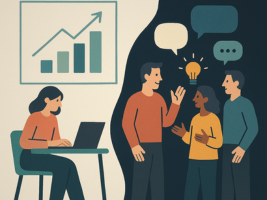“The only people who achieve much are those who want knowledge so badly that they seek it while the conditions are still unfavorable. Favorable conditions never come.” ~ C. S. Lewis
INTRODUCTION
Information is power. And, it is the core requisite to construct knowledge. In this knowledge era, people who can locate information quickly are considered to be more knowledgeable than those who carry information with them. There is a clear shift in the definition of ‘knowledge’. Hence, mastering search skills is one of the most important skills in today’s workplace.
Here are a few interesting facts (adapted from various research reports) related to the amount of time that we spend searching for information on the World Wide Web (WWW):
- Google is the most visited web site in the world.
- 43.78% of Internet users visit Google daily.
- Any particular visitor visits Google 13.5 times in a given day; he/she stays on Google for 12:02 minutes.
SMART WEB SEARCHING
How do you rate yourself on your web search skills? Take a look at these statements (below):
- I know how to search for an exact word or phrase.
- I know how to use wildcards and fill-in-the-blank techniques to find exact information.
- I know how to exclude particular items in my search results.
- I know how to search within a specific site.
- I know how to search by a particular location.
- I know how to search for items within a number range.
- I know how to search by file type.
- I know how to check weather, time, etc. of any place in the world.
- I know how to get world news, real-time stock news, etc.
- I know how to find recipes, a local store, etc.
- I know how to search by images and voice.
- I know how to examine public data.
In case your answers for some of the above statements are ‘No’, it may be a good idea to look at ways to further sharpen your web search skills. This could help you make yourself more productive in your personal and professional lives.
Here are our observations on three of the most effective instructional programs that are aimed at equipping people with smart web searching skills (using Google Search Engine, Google Maps, and Google Earth).
A-GOOGLE-A-DAYThe one that’s most interesting and hence the first in our list of instructional resources is – ‘A Google-A-Day’ – a lateral thinking daily puzzle/game from Google that helps enhance your creativity and smart search skills.
We found this game highly interesting and engaging; here are the reasons:
- The ‘game’ element that makes learning truly ENTERTAINING
- The ‘bite-sized’ content granularity the game offers (a set of six questions each day) that makes learning EFFORTLESS
- The dynamically changing Points (based on the time you take to answer questions) that make the game LIVELY
- The Hints and Clues (and even a ‘Skip Question’ option) available to assist you in solving the puzzle at your own comfort (which gives you CONFIDENCE)
- The Badges, Goals, and Rewards that boost your MOTIVATION
- The opportunity provided to solve the puzzle using your own ways, making the game resemble REAL-LIFE SITUATIONS (As Google says, “There’s no right way to solve a puzzle, but there’s only one right answer”)
- The dynamically increasing difficulty level of the puzzle questions over the course of the week that makes the game ENGAGING
- The innovation in the concept (of encouraging us to use Google for solving the puzzles) that makes the whole experience MEMORABLE and FASCINATING
In addition to the points discussed above, we were captivated by the technological innovation that makes the game highly intriguing. As you can read on the website, the game is powered by Deja Google – a version of Google Search Engine that allows you to solve puzzles by searching the Internet – a version (of the Internet) that existed before this game was launched!
What, according to you, would’ve inspired Google to use a still-capture of Internet for this game? Click the following link below to experience ‘A Google-A-Day’ and solve many other puzzles – http://agoogleaday.com/#
POWER SEARCHING WITH GOOGLEPower Searching with Google is second on our list resources. It is an online, self-paced course that’ll help you master your web searching skills. This highly engaging course comprises the following levels:
- Power Searching: In this basic level course that is composed of six classes (with five lessons for each class), you will learn the tips and tricks for making your Google searches more effective and efficient. This course will help you transform yourself into a fast and effective fact finder.
- Advanced Power Searching: This advanced level course will help you master your web searching skills by solving complex search challenges. The course is composed of 13 highly interesting challenges for you to solve. This includes a sample challenge (with solution) and tips and techniques to solve the given challenges.
We found this course (both levels) highly engaging and effective; here are the reasons:
- Short but powerful instructor videos (one for each lesson) that explain the concepts in a highly interesting way
- Highly engaging hands-on practice activities (after each video) that let you try the techniques discussed in the course
- Challenges (in 3 difficulty levels – Easy, Medium, Hard) for you to learn and practice advanced search skills
However, as you can observe, the (Course Completion) certifications and collaborative learning through online Forums are not supported presently since these were available only in the synchronous versions of these courses.
Here are the links for you to experience the courses:
- Power Searching: http://www.powersearchingwithgoogle.com/course/ps/course.html
- Advanced Power Searching: http://www.powersearchingwithgoogle.com/course/aps
MAPPING WITH GOOGLEThe third resource is ‘Mapping with Google’- a self-paced online course that’ll help you master your mapping skills by applying what you learn in the program. This course helps discover new ways to navigate the world around you with Google Maps and Google Earth. You’ll also learn to annotate and create your own maps using Google Maps Engine Lite. The course consists of five units with a set of lessons and activities for you to complete in each unit.
We found this course highly engaging; here are the reasons:
- Short instructor videos (one for each lesson) that explain the concepts in a highly interesting way
- Highly engaging hands-on practice activities(after each video) that let you try the techniques discussed in the course
- Highly captivating projects for you to practice advanced mapping skills
Here is the link for you to experience this course – https://mapping.withgoogle.com/
OTHER RESOURCES
- Google Search powers one-hundred billion searches each month. That’s amazing! But, how do you think Google Search works? Right from the keyword to the search algorithm to the index file to page ranking and so on…it should be a great juggling journey. If you would like to take another quick look at the (behind the scene) techniques, check out this beautiful presentation.
- We also stumbled upon a few very interesting stories about how people all around the world were successful in turning things around using Google Search. Here is a video on one of the most inspiring Google Search stories.
- Finally, to put things in a nutshell, here is an infographic on ‘Googling Tips’ for your ready reference.
THE BOTTOM LINE
Almost all organizations in the knowledge business devote quality time on research and development, not just to keep themselves abreast of the latest educational technologies and trends, but also to find ways for innovative thinking and ideas that could help leverage their business goals. However, for achieving this, information stands as the key factor. The quality of knowledge they could construct is greatly dependent on the quality of information they procure, which again is directly proportional to the research skills their people possess. This clearly signifies the need to have a process (as part of a training plan) to empower employees for smart searching in the bigger picture of the organization’s business goals.
What are the innovative resources and techniques that you use to equip your employees with smart web searching skills? What are your experiences on using those in your workplace? Let us know.
Written by Santhosh Kumar
_________________________________
Published on 21-Aug-2013






